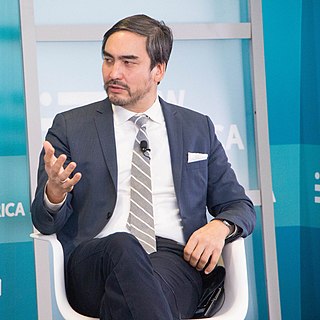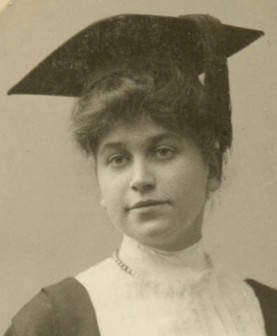
Joan Ruth Bader Ginsburg was an American lawyer and jurist who served as an associate justice of the Supreme Court of the United States from 1993 until her death in 2020. She was nominated by President Bill Clinton to replace retiring justice Byron White, and at the time was viewed as a moderate consensus-builder. Ginsburg was the first Jewish woman and the second woman to serve on the Court, after Sandra Day O'Connor. During her tenure, Ginsburg authored the majority opinions in cases such as United States v. Virginia (1996), Olmstead v. L.C. (1999), Friends of the Earth, Inc. v. Laidlaw Environmental Services, Inc. (2000), and City of Sherrill v. Oneida Indian Nation of New York (2005). Later in her tenure, Ginsburg received attention for passionate dissents that reflected liberal views of the law. She was dubbed "the Notorious R.B.G.", a moniker she later embraced.

Felix Frankfurter was an Austrian-born American jurist who served as an Associate Justice of the Supreme Court of the United States from 1939 until 1962, during which period he was a noted advocate of judicial restraint in its judgements.

Harlan Fiske Stone was an American attorney and jurist who served as an associate justice of the U.S. Supreme Court from 1925 to 1941 and then as the 12th chief justice of the United States from 1941 until his death in 1946. He also served as the U.S. Attorney General from 1924 to 1925 under President Calvin Coolidge, with whom he had attended Amherst College as a young man. His most famous dictum was: "Courts are not the only agency of government that must be assumed to have capacity to govern."

Benjamin Nathan Cardozo was an American lawyer and jurist who served on the New York Court of Appeals from 1914 to 1932 and as an Associate Justice of the Supreme Court of the United States from 1932 until his death in 1938. Cardozo is remembered for his significant influence on the development of American common law in the 20th century, in addition to his philosophy and vivid prose style.

Glenn Cartman Loury is an American economist, academic, and author. He is the Merton P. Stoltz Professor of the Social Sciences and Professor of Economics at Brown University, where he has taught since 2005. At the age of 33, Loury became the first African American professor of economics at Harvard University to gain tenure.

Timothy "Tim" Shiou-Ming Wu is a Taiwanese American legal scholar who served as Special Assistant to the President for Technology and Competition Policy from 2021 to 2023. He is also a professor of law at Columbia University and a contributing opinion writer for The New York Times. He is known legally and academically for significant contributions to antitrust and communications policy, coining the phrase "network neutrality" in his 2003 law journal article, Network Neutrality, Broadband Discrimination. In the late 2010s, Wu was a leading advocate for an antitrust lawsuit directed at the breakup of Facebook.
Paul Finkelman is an American legal historian. He is the author or editor of more than 50 books on American legal and constitutional history, slavery, general American history and baseball. In addition, he has authored more than 200 scholarly articles on these and many other subjects. From 2017 - 2022, Finkelman served as the President and Chancellor of Gratz College, Melrose Park, Pennsylvania.

Wallach Hall is the second oldest residence hall on the campus of Columbia University, and currently houses undergraduate students from Columbia College as well as the Fu Foundation School of Engineering and Applied Science. It opened in 1905 as "Livingston Hall" after Robert Livingston, a Founding Father of the United States and alumnus of King's College, Columbia's predecessor, but its name was changed after Ira D. Wallach donated approximately $2 million towards its renovation. This gave rise to the joke, "Livingston signed the Declaration of Independence, Wallach signed a check."

James Clark McReynolds was an American lawyer and judge from Tennessee who served as United States Attorney General under President Woodrow Wilson and as an associate justice of the Supreme Court of the United States. He served on the Court from 1914 to his retirement in 1941. McReynolds is best known today for his sustained opposition to the domestic programs of President Franklin D. Roosevelt and his personality, which was widely viewed negatively and included documented elements of overt antisemitism and racism. Born in Elkton, Kentucky, McReynolds practiced law in Tennessee after graduating from the University of Virginia School of Law. He served as the U.S. Assistant Attorney General during President Theodore Roosevelt's administration and became well known for his skill in antitrust cases. After Wilson took office in 1913, he appointed McReynolds as his administration's first attorney general. Wilson nominated McReynolds to the Supreme Court in 1914 to fill the vacancy caused by Associate Justice Horace Harmon Lurton's death.
Constitutional avoidance is a legal doctrine in United States constitutional law that dictates that United States federal courts should refuse to rule on a constitutional issue if the case can be resolved without involving constitutionality. When a federal court is faced with a choice of ruling on a statutory, regulatory, or constitutional basis, the Supreme Court of the United States has instructed the lower court to decide the federal constitutional issue only as a last resort: "The Court will not pass upon a constitutional question although properly presented by the record, if there is also present some other ground upon which the case may be disposed of." Ashwander v. Tennessee Valley Authority, 297 U.S. 288, 347 (1936).

Louis Dembitz Brandeis was an American lawyer who served as an associate justice on the Supreme Court of the United States from 1916 to 1939.

Adele Brandeis (1885–1975) was an American art administrator from Louisville, Kentucky.
Students for Fair Admissions v. Harvard, 600 U.S. ___ (2023), is a landmark decision of the Supreme Court of the United States in which the court held that race-based affirmative action programs in college admissions processes violate the Equal Protection Clause of the Fourteenth Amendment. With its companion case, Students for Fair Admissions v. University of North Carolina, the Supreme Court effectively overruled Grutter v. Bollinger (2003) and Regents of the University of California v. Bakke (1978), which validated some affirmative action in college admissions provided that race had a limited role in decisions.
The following are some of the books and papers which have been written concerning William Howard Taft, the 27th president of the United States:

The Hughes Court refers to the Supreme Court of the United States from 1930 to 1941, when Charles Evans Hughes served as Chief Justice of the United States. Hughes succeeded William Howard Taft as Chief Justice after the latter's retirement, and Hughes served as Chief Justice until his retirement, at which point Harlan Stone was nominated and confirmed as Hughes's replacement. The Supreme Court moved from its former quarters at the United States Capitol to the newly constructed Supreme Court Building during Hughes's chief-justiceship.

The Stone Court refers to the Supreme Court of the United States from 1941 to 1946, when Harlan F. Stone served as Chief Justice of the United States. Stone succeeded the retiring Charles Evans Hughes in 1941, and served as Chief Justice until his death, at which point Fred Vinson was nominated and confirmed as Stone's replacement. He was the fourth chief justice to have previously served as an associate justice and the second to have done so without a break in tenure. Presiding over the country during World War II, the Stone Court delivered several important war-time rulings, such as in Ex parte Quirin, where it upheld the President's power to try Nazi saboteurs captured on American soil by military tribunals. It also supported the federal government's policy of relocating Japanese Americans into internment camps.

The Vinson Court refers to the Supreme Court of the United States from 1946 to 1953, when Fred M. Vinson served as Chief Justice of the United States. Vinson succeeded Harlan F. Stone as Chief Justice after the latter's death, and Vinson served as Chief Justice until his death, at which point Earl Warren was nominated and confirmed to succeed Vinson.

The Taft Court refers to the Supreme Court of the United States from 1921 to 1930, when William Howard Taft served as Chief Justice of the United States. Taft succeeded Edward Douglass White as Chief Justice after the latter's death, and Taft served as Chief Justice until his resignation, at which point Charles Evans Hughes was nominated and confirmed as Taft's replacement. Taft was also the nation's 27th president (1909–13); he is the only person to serve as both President of the United States and Chief Justice.
Patricia Gurin is a social psychologist known for her work documenting the benefits of student and faculty diversity in higher education. She is the Nancy Cantor Distinguished University Professor Emerita of Psychology and Women's Studies at The University of Michigan.
Karen L. "Kerry" Abrams is an American law professor and academic administrator. She currently serves as the James B. Duke and Benjamin N. Duke Dean of the Duke University School of Law.














